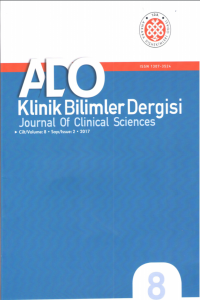Pulpa Hastalıklarında Bakterilerin Rolü
Bakteriler olmadan, ekspoze pulpada sadece hafif düzeyde enflamasyonların oluştuğu kabul edilmiş bir gerçektir. Pulpal apseler, periapikal periodontitisler, periapikal şişlik ve ağrı; karma mikrobiyal enfeksiyonlar sonucu oluşmaktadır. Endodontik enfeksiyonlarda rol oynayan mikroorganizmalar ve karma enfeksiyonlarda bunların birbiriyle olan ilişkilerinin keşfedilmesi bir çok araştırmanın konusu olmuştur.Bu mikroorganizmaların yıkım potansiyellerinin, üremeleri için gereksinimlerinin, giriş yollarının, ilaçlara karşı hassasiyetlerinin, birbirleriyle olan sinerjistik etkileşimlerinin ve klinik semptomlarla olan ilişkilerinin anlaşılması; kök kanal tedavisine yeni yaklaşımların getirilmesini gerektirmektedir
Anahtar Kelimeler:
Diş aşınması, Restorasyon, Estetik
The role of bacteria in pulpal diseases
It was accepted that without bacterial involvement, only minor inflammation occured in exposed pulps. Pulpal abcesses, periapical periontitis, swelling, and pain are the result of mixed microbial infections. Discovery of the microorganisms that play roles in endodontic enfections and their relationship with each other in mixed infections point to the close relationship between basic science and clinical practise in the special field of endodontics.Discovering of these microorganisms, including their destructive potential, their requirements for growth, their routes of entry, their sensitivity to pharmacotherapeutic agents, their synergistic dependence on each other, and their relationship to clinical symptoms is necessary to formulate a new approach to root canal therapy
Keywords:
Tooth wear, Restoration, Aesthetic,
___
- Seltzer S. Endodontology: Biologic Considerations in Endodontic Procedures. 2nd ed. Philadelphia, Lea and Febiger, 1988, 326-344.
- Aydın M. Endodontik Mikrobiyoloji: Alaçam T. ed. Endodonti 2. baskı. Ankara: Fakülteler Kitapevi Barıs Yayınları, 2000, 313–384.
- Baumgartner JC. Endodontic Microbiology: Wal- ton RE, Torabinejad M. editors. Principles and practise of Endodontics. 3rd ed. Philadelphia: W.B. Saunders Company, 2002, 282-294.
- Morse DR. Microbiology and pharmacology: Co- hen S, Burns RC,editors. Pathways of the pulp . 2nd ed. St.Louis: The C.V. Mosby Company, 1980, 321-339.
- Pisano JV, Weine FS. Microbiology of endodontics:Weine FS, editor. Endodontic The- rapy. 5th. ed. St. Louis:Mosby Year Book Inc., 1996, 693-712.
- Goodman AD, Nisengard RJ. Periapical Infecti- ons: Newman MG, Nisengard RJ, editors. Oral Microbiology and Immunology. 1st ed. Philadelp- hia: W.B. Saunders Company, 1988, 447-454.
- Bergenholtz G.Inflammatory response of the dental pulp to bacterial irritation. J Endod.7:100,1981.
- Cvek M. A clinical report on partial pulpotomy and capping with calcium hydroxide in perma- nent incisors with complicated crown fractures. J Endod.4: 232-7,1978.
- Delivanis PD, Fan VS. The localization of blood- borne bacteria in instrumented unfilled and over instrumented canals. J Endod. 10: 521-524, 1984.
- Sundqvist G. Associations between microbial spe- cies in dental root canal infections. Oral Microbiol Immunol.7:257,1992.
- Dahlen G, Haapasalo M. Microbiology of apical periodontitis. In:Ørstavik D, Ford TRP, editors. Es- sential Endodontology Prevention and Treatment of Apical Periodontitis. 1st ed. Oxford: Blackwell Publihing Company, 1998, 106-130.
- Seltzer S, Farber PA. Microbiologic factors in en- dodontology. Oral Surg Oral Med Oral Pathol. 78: 634-645, 1994.
- Tomic-Karovic K, Jelinek E.Comparative study of the bacterial flora in the surrounding, the root ca- nals and sockets of deciduous molars. Int Dent J. 21:375-88, 1971.
- Schuster GS. Oral Microbiology and Infectious Di- sease. 3rd ed. Philadelphia: B.C.Decker Inc.,1990, 562-548.
- Ang Ö. Agız Mikrobiyolojisi. İstanbul: Nobel Tıp Kitapevi, 1990, 359-379.
- Ryan KJ, Ray CG. Ed. Sherris Medical Microbio- logy. 4th ed. Mc Graw Hill, 2004,294-5.
- Borssen E, Sundqvist G. Actinomyces of infected dental root canals. Oral Surg Oral Med Oral Pat- hol. 51: 643-648, 1981.
- Hawser SP, Douglas LJ. Biofilm formation by Can- dida species on the surface of catheter materials in vitro. Infect Immun. 62: 915-921, 1994.
- Van Winkelhoff AJ, Van Steenbergen TJ, De Gra- aff J. Porphyromonas (Bacteroides) endodontalis: Its role in endodontal infections. J Endod. 18: 431- 434, 1992.
- Griffee MB, Patterson SS, Miller CH, Kafrawy AH, Newton CW. The relationship of Bacteroides me- laninogenicus to symptoms associated with pulpal necrosis. Oral Surg Oral Med Oral Pathol. 50: 457- 461, 1980.
- Bae KS, Baumgartner JC, Shearer TR, David LL. Occurrence of Prevotella nigrescens and Prevotel- la intermedia in infections of endodontic origin. J Endod. 23: 620-623, 1997.
- Dougherty WJ, Bae KS, Watkins BJ, Baumgartner JC. Blackpigmented bacteria in coronal and api- cal segments of infected root canals. J Endod. 24: 356-358, 1998.
- Rocas IN, Siqueira JF Jr, Andrade AF, Uzeda M. Oral treponemes in primary root canal infections as detected by nested PCR. Int Endod J. 36: 20-26, 2003.
- Baumgartner JC, Falkler WA Jr. Bacteria in the apical 5mm of infected root canals. J Endod. 17: 380-383, 1991.
- Gomes BP, Jacinto RC, Pinheiro ET, Sousa EL, Zaia AA, Ferraz CC, Souza-Filho FJ. Porphyromonas gingivalis, Porphyromonas endodontalis, Prevo- tella intermedia and Prevotella nigrescens in en- dodontic lesions detected by culture and by PCR. Oral Microbiol Immunol. 20: 211-215, 2005.
- Heimdal A, Von Know L, Satoh T, Nord CE. Clini- cal apperance of orofacial infections of odontoge- nic origin in relation to microbial findings. J Clin Microbiol. 22: 299-302, 1985.
- Tani-Ishii N, Wang CY, Taner A, Stashenko P. Changes in root canal microbiota during the deve- lopment of rats periapical lesions . Oral Microbiol Immunol. 9: 129-135, 1994.
- Shah HN, Collins DM. Prevotella, a new genus to include Bacteroides melaninogenicus and related species formerly classified in the genus Bacteroi- des. Int J Syst Bacteriol. 40: 205-208, 1990.
- Gomes BP, Drucker DB, Lilley JD. Associations of specific bacteria with some endodontic signs and symptoms. Int Endod J. 27: 291-298, 1994. Dr. R.Ebru TİRALİ
- Başkent Üniversitesi Diş Hekimliği Fakültesi, Pedodonti Anabilim Dalı, 11.sok. No:26 Bahçelievler / Ankara Tel Faks
- ISSN: 1307-3540
- Yayın Aralığı: Yılda 3 Sayı
- Başlangıç: 2006
- Yayıncı: Ankara Diş Hekimleri Odası
Sayıdaki Diğer Makaleler
Komplike Kron Kırıklarında Vital Pulpa Tedavisi
Zeynep Başak ÖKTEM, Levent ÖZER
Pulpa Hastalıklarında Bakterilerin Rolü
Resmiye Ebru TİRALİ, Haluk BODUR
M Cenk DURMUŞLAR, M Kağan DEĞERLİYURT, Barış ŞİMŞEK
Tükürük Salya ; Özellikleri ve Görevleri Tanı Açısından Değeri
Alper AKTAŞ, Bahadır GİRAY, Güliz AKTAŞ
